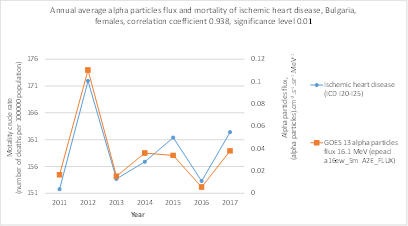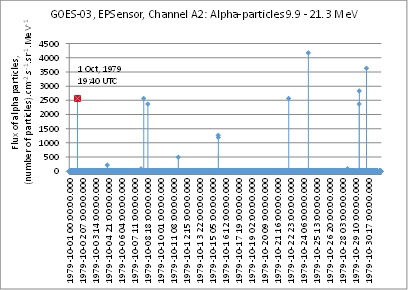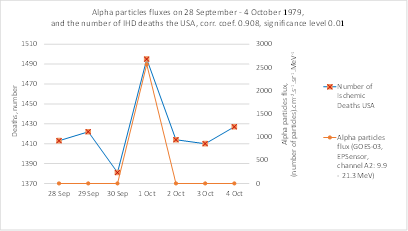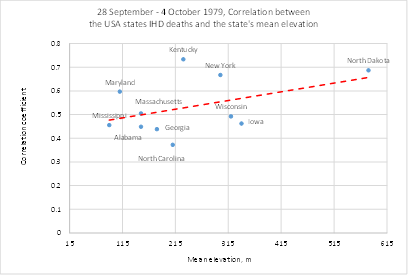International Journal of
eISSN: 2381-1803


Research Article Volume 16 Issue 4
Associate Professor, Trakia University, Stara Zagora, Bulgaria
Correspondence: Nikolay Takuchev, Trakia University, City of Stara Zagora, Bulgaria
Received: June 15, 2023 | Published: August 21, 2023
Citation: Takuchev N. Solar alpha particles and death from ischemic heart disease. Int J Complement Alt Med. 2023;16(4):228-232. DOI: 10.15406/ijcam.2023.16.00657
According to the World Health Organization, ischemic heart disease is at the top of the list of morbid causes of death on the planet. In the present work: 1. Data are given showing the probable impact of positively charged particles of solar origin with high energy on mortality from ischemic heart disease; 2. A hypothetical mechanism is proposed to explain this phenomenon; and 3. This mechanism can be used to determine from satellite data specific points on the planet's surface where increased mortality from ischemic heart disease should have occurred on specific dates. The hypothetical mechanism was applied to analyze a sudden unexplained spike in the number of deaths from ischemic heart disease in the United States on October 1, 1979.
Keywords: ischemic heart disease, coronary heart disease, solar alpha particles, deaths, mortality, goes satellites
WHO, world health organization; IHD, ischemic heart disease; ICD, 10th revision, international disease classifier; CDC, centers for disease control and prevention, USA; NCHS, national center for health statistics for the USA; GOES, geostationary operational environmental satellites; NOAA, national oceanic and atmospheric administration; EPS, energetic particles sensor; EPEAD, energetic proton, electron, and alpha detector; HEPAD, high energy proton and alpha detector; SME, solar mass ejections; UTC, universal time coordinated
According to statistics from the World Health Organization (WHO), ischemic heart disease (IHD) is at the top of the list of disease causes of death on the planet.1 In the International Disease Classifier (ICD, 10th revision) IHDs are classified in classes I20 – I25. According to WHO data, 8.9 million people died worldwide from IHD in pre-pandemic 2019.2 According to3 the incidence and mortality of IHD (the number of cases and the number of deaths from IHD per 100,000 people) are not spread evenly across the planet. The highest mortality from IHD is in a region including Central and Eastern Europe. Causes of death from IHD can be heredity, age, sex, lifestyle, and diseases. A study was conducted aimed at clarifying whether IHD deaths were related to external causes – geomagnetic field interference, solar radiation – corpuscular and electromagnetic (X-ray and ultraviolet radiation), the cyclicity of solar activity, and variations of galactic cosmic rays. As a result of this study, a space phenomenon was noticed which also contributes to IHD mortality. In the following, some of the results of the study are described.
A prerequisite for this kind of study is the availability of reliable data – both on possible space impacts and mortality from IHD. More complex is the problem of the reliability of mortality data. Their obtainment requires a combination of good medical diagnostics covering the territory of the respective country, accurate administrative reporting, adequate national statistics, and easy access to statistical data for scientific purposes.
The analysis below is based on medical statistics from Eurostat4 for Bulgaria and from the National Center for Health Statistics (NCHS)5 for the USA, for which the requirements listed above are fulfilled to the greatest extent. Bulgaria is located in the mentioned region with the highest death rate on the planet from IHD.
The U.S. is not the most affected by this cosmic phenomenon, but it is included in the study because it has detailed medical statistics and access to it for researchers around the world is easy and free. The United States is the only country in the world to provide records of all individual deaths within the country. They are a symbolic line of codes with a variety of information about the deceased. For the study, software was created to extract information about the location (state), month and day of death, and the cause of death by ICD. This gives the possibility to track rapid changes (per day) in mortality from IHD and to draw conclusions about the possible dependence of mortality from IHD with short-term processes in near-Earth space. Unfortunately, the day of death was included in the individual records only until 1992, after which it was no longer monitored. This limits the study of rapid changes in mortality to 1992 only.
Satellite data on solar corpuscular radiation – protons and alpha particles recorded by the Geostationary Operational Environmental Satellite (GOES) series satellites were obtained from an NOAA site.6 The satellites of the GOES series fly in geostationary orbit (above the Earth's equator), at an altitude of 36,000 kilometers above the Earth's surface and make one lap in 24 hours, that is, they "hang" over a certain point on the surface, do not shade from the Earth at their circumference around it. There is one satellite of the series over each of two meridians – over the east coast and the west coast of the United States. Data on alpha-particle and proton fluxes (unit: (number of particles). cm-2.s-1.sr-1.MeV-1) were used with energies of the range 3.8–21.3MeV. The fluxes were recorded by the satellite high-energy particle detectors Energetic Particles Sensor (EPS) and Energetic Proton, Electron, and Alpha Detector (EPEAD). The detectors detect in particular alpha particles with energies from 3.8MeV to 260MeV, distributed in 6 channels. The data are averaged over a 5-minute interval, during which there are up to 25reports of the instrument. Particle fluxes become frequent and grow in size over several years, then almost disappear to reappear over time. The largest in value and the most frequent flows for the duration of the GOES satellites were recorded in the interval 1975–1979, of which are the examples below.
Part of the satellite data was processed statistically – it was averaged by year and correlations were sought between their average annual values and the annual mortality from IHD for Bulgaria. The number of years included in the study of the dependence of annual mortality from IHD in Bulgaria on corpuscular solar radiation was consistent with the longest possible continuous interval years with satellite data. The data from the GOES-13 satellite was used, whose flawless operation in orbit lasted the longest in the harsh conditions of space – 7 years (from 2011 to 2017).
To track rapid changes in mortality, the number of deaths per day was calculated, both for the entire U.S. and for individual states. The calculations were made for intervals of 7 days. The intervals were chosen to cover the days with satellite-recorded peak values of particle fluxes.
To the extent that the hypothetical mechanism proposed below explaining the observed phenomenon assumes that charged particles of high energy pass through the atmosphere and reach the Earth's surface, the energy required for this was calculated from databases and calculators PSTAR and ASTAR.7,8 Geomagnetic field data were obtained from the INTERMAGNET site.9 Galactic cosmic ray data were obtained from the NMDB database for 5 European neutron monitors.10,11 Data on solar activity, solar mass discharges (Solar Mass Ejections, SME), solar flares, and coronal holes were obtained from sites.12–16 Correlation analysis was used to process the data.
A high statistically significant correlation was found (Figure 1) between the annual average alpha-particle (and proton) fluxes with high energy in the range 3.8MeV–16.1MeV recorded with the high energy particle sensor EPEAD and the annual mortality from IHD for females, Bulgaria. Slightly higher was the correlation of IHD mortality with annual average alpha-particle fluxes, compared to that with proton fluxes.

Figure 1 There is a high correlation between mortality from IHD for females in Bulgaria according to Eurostat data4 and the annual flow of alpha particles in geostationary orbit recorded by the GOES-13 satellite.6
The correlation with the average annual alpha particle flux is higher for the mortality of IHD in women compared to that for men in Bulgaria. According to data on the age of those who died from IHD, it became clear that these were mostly elderly people. Women are more affected, as men in Bulgaria live shorter lives - for example, for the pre-pandemic interval 2017 - 2019, the average life expectancy for women in Bulgaria was 78.0 years, and for men 70.8 years, with the number of men in the age range 70-74 years is 70% of the number of women.17
For Bulgaria, the contribution of positively charged cosmic radiation to mortality from IHD has been estimated at 10–15%, but a similar analysis for Malta shows a proportion of radiation in IHD mortality of up to 40%.18
Particles of relatively small energy are constantly emitted from the Sun, spreading in all directions in the surrounding cosmos – the so-called solar wind. When they invade the Earth's atmosphere, they deviate from the geomagnetic field to the poles, where they enter deeper into the atmosphere. If solar wind particles are the cause of the increased mortality, their effects should be expected to be more noticeable in countries closer to the poles, but such an increase in mortality is not noticeable in countries near the North Geographic Pole. There are no sufficiently reliable and long sequences of mortality data in the Southern Hemisphere, so all the reasoning below is about the Northern Hemisphere.
A well-pronounced relationship between the annual average flux of positively charged high-energy cosmic rays and the annual average mortality from IHD is only noticeable for some small area countries of mid-latitudes.18 For large countries such as the USA, located at the same latitude as Europe, the average annual mortality from IHD does not depend on the average annual flux of high-energy positively charged cosmic rays. This observation leads to the conclusion that if there is a lethal effect of high-energy positively charged particle radiation on mortality, it is short-lived in time and is in the form of a spatially variable patch of a limited area on the Earth's surface (deadly spot). The effect on mortality from such radiation is noticeable in the statistics of countries with a small area covered entirely by this impact spot but is masked in the statistics of the large countries where it affects only part of the total territory of the country. Masking is the stronger the shorter the impact and when a small part of the territory of the large country is covered by the deadly spot. The alpha radiation recorded by satellites is not continuous over time but is the result of individual short-term peaks. It is natural to expect that it is during these peaks that the harmful effects linking alpha radiation to IHD mortality occur. Figure 2 shows fluxes for a series of short-lived alpha particle peaks streams, recorded within October 1979. Their duration is less than 5 minutes (the time of averaging the sensor data). They differ in magnitude and time of appearance. Depending on their magnitude, they can have different effects, and depending on the time of their appearance, they can appear over different points on the planet. The analysis below refers to the October 1, 1979 peak recorded at 19:40 UTC, which is local noon for the western United States. The detailed data on individual deaths allows the number of deaths from IHD to be calculated for each of the days of a selected interval and their change to be compared with the change in alpha particle flux in the same interval. A seven-day interval around October 1st, the day with the peak alpha particle flux, from September 28th to October 4th, was chosen for the study. The reasons for choosing this alpha particle stream are explained below in the exposition. The result is shown in Figure 3.

Figure 2 Several peak streams of alpha particles lasting minutes reaching Earth's orbit were recorded during October 1979. The time of registration of the marked peak on October 1st, 19:40 UTC (Universal Time Coordinated), corresponds to local noon over the western US.

Figure 3 For the time interval September 28 – October 4, 1979, there is a high, statistically significant (i.e., reliably established) correlation between the number of IHD deaths in the US and the alpha particle flux recorded by GOES-03.
For the time interval September 28 – October 4, 1979, there is a high, statistically significant (i.e., reliably established) correlation between the number of IHD deaths in the US and the alpha particle flux recorded by GOES-03.
Mean altitude correlates positively with IHD mortality in countries where the impact of alpha radiation on IHD mortality is noticeable.18
Figure 4 shows for the time interval September 28-October 4, 1979, the dependence of the correlation coefficient between the number of death cases from IHD for individual states for which this correlation is positive and relatively large (greater than 0.3) and the flux of alpha radiation for the same time. A dashed line shows an upward trend, i.e. the correlation coefficient also in this case shows an increasing trend with increasing average elevation for the state.

Figure 4 There is a statistically significant correlation between the alpha radiation flux for the time interval September 28 - October 4, 1979, and the number of deaths in New York County for the same period.
This fact shows that the threat of death due to IHD hangs over our heads and that the impact of alpha radiation on IHD mortality increases with distance from the Earth's surface. The increase in mortality from IHD with height can be explained by the health impact of invading alpha radiation from space that reaches the Earth's surface. At high altitudes, the atmospheric layer in which alpha radiation penetrates is thinner and less dense, as a result of which the radiation flux weakens less and its negative impact on living organisms is stronger. The risk of death from CHD is higher in the mountains.
Two observational facts related to the timing of the alpha particle stream on October 1 are noteworthy:
The High Energy Proton and Alpha Detector (HEPAD) of the GOES-13 satellite is designed to detect protons reaching Earth orbit with energies up to and above 0.7GeV, as well as alpha particles with energies up to and above 3.4GeV.6 The detector data show that the average proton flux rapidly decreases with the increase in energy and is negligible for energies above 0.7GeV. The average alpha-particle flux at first decreases with increasing energy but then increases for energies above 3.4GeV. It follows that particles with energies of a few GeV can only be alpha particles, so the reasoning and figures above apply only to streams of alpha particles. Alpha particles detected by satellites in Earth orbit have received a large acceleration. For comparison, the source of unaccelerated alpha radiation with the greatest energy on the Earth's surface, the radionuclide Californium-252, emits alpha particles with an energy of 6.217MeV, which is two orders of magnitude less energy than the energy of the alpha particles registered by satellite detectors.19 No statistically significant correlations of IHD mortality were found for the other possible space impacts listed above.

Figure 5 Dependence of the correlation coefficient between the number of IHD deaths and mean altitude for some states with a positive correlation coefficient. The increasing trend with altitude indicates that the threat of IHD increases with elevation above sea level.
Hypothetical mechanism of the described phenomenon
The moments of invasion of alpha particles are unpredictable, but the dates of the maximum risk from them (the dates of coincidence of the two directions-of the movement of the alpha particles and the direction of the geomagnetic vector) can be calculated according to the proposed hypothetical mechanism from the latitude data of the site.18 As stated above, the dates of maximum risk of alpha particle damage during a midday outdoor walk estimated by the proposed hypothetical mechanism for Los Angeles are February 26 and October 15, and for New York, they are April 6–7 and 5–September 6.
The work presents a study revealing a planet-wide health problem – a correlation between the fluxes of solar alpha particles with high energy recorded by satellite detectors in Earth orbit and mortality from the number one killer disease for humanity – ischemic heart disease.
The author expresses his gratitude to the thousands of specialists from NOAA, CDC, USA, and Eurostat, EU, without whose noble work the research presented in this work would have been impossible.
None.

©2023 Takuchev. This is an open access article distributed under the terms of the, which permits unrestricted use, distribution, and build upon your work non-commercially.